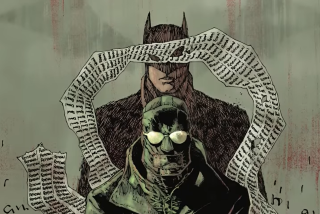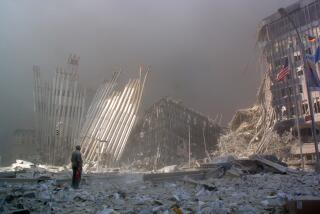Chaos, drawn out
WHEN writer Sid Jacobson and artist Ernie Colon turned the 9/11 Commission Report into a graphic novel two years ago, it seemed a sacrilegious mission. How could a policy document drafted with measured solemnity lend itself to sound effects like “BLAAMMM!” and “KA-POW!”? Would such a rendering not make mockery of the tragedy? And what would Jacobson and Colon do with all those detailed passages tracing U.S. security lapses going back to Iran-Contra?
As it turned out -- and as graphic artists have shown before -- the comic book form doesn’t undermine gravitas, nor does it need to gloss over minutiae to keep audiences rapt. Joe Sacco humanized far-off conflicts in his books “Palestine” and “Safe Area Gorazde: The War in Eastern Bosnia 1992-1995”; Art Spiegelman’s monumental “Maus” memorialized the Holocaust for a new generation. Colon and Jacobson’s “The 9/11 Report” had a similar effect, helping to lure us into the weightier text. Upon finishing it, I ordered up the real thing and immersed myself in its 400-plus pages for a week.
What a graphic novel does need, however, is a story line or two, preferably with suspense to keep us moving from one panel to the next. “The 9/11 Report” had these in abundance, whether in the attackers’ puzzling march past beeping metal detectors or the chilling cellphone calls of doomed flight attendants. Yet Jacobson and Colon are less well served by the jumble of horrors that have followed: Their latest effort, “After 9/11: America’s War on Terror (2001- ),” is admirable but impenetrable -- precisely as excruciating to absorb as the last seven years have been to live.
In “After 9/11,” Jacobson and Colon present a serial recounting of the war on terror: every false assertion and its debunking, every leak and its consequences, every ignored bit of evidence that might have stopped our march into Iraq. The book portrays, in equal parts, talking heads, bloody insurgent attacks (and in this case, the blood-spattered “BRAK-ATAK!” seems trivializing) and explanations of ethnic divisions and political history. The whole thing comes off as chaotic and pointless and sickening -- not unlike reality, perhaps, but hardly enlightening.
Not even the most casual observer will find much news in this kitchen-sink history, which reads less like an effort to inform than a comic book wail of protest. That may be an appropriate response to these many long years of bungling and carnage, but it isn’t one that can sustain a book.
--
Judith Lewis is a freelance writer.
More to Read
Sign up for our Book Club newsletter
Get the latest news, events and more from the Los Angeles Times Book Club, and help us get L.A. reading and talking.
You may occasionally receive promotional content from the Los Angeles Times.







